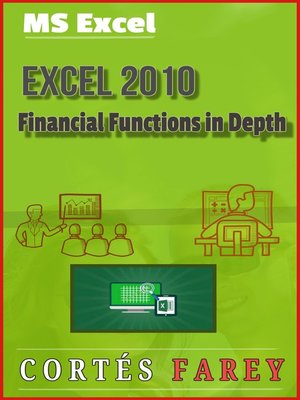
Sign up to save your library
With an OverDrive account, you can save your favorite libraries for at-a-glance information about availability. Find out more about OverDrive accounts.
Find this title in Libby, the library reading app by OverDrive.



Search for a digital library with this title
Title found at these libraries:
| Library Name | Distance |
|---|---|
| Loading... |
NB: There are Video Tutorials supporting this eBook. Link to video training is inclusive.
In this course, the author will show how to perform a wide range of financial calculations quickly and easily using the many financial functions found in Excel 2010. The course details dozens of functions for evaluating cash flows; calculating depreciation; determining rates of return, bond coupon dates, and security durations; and more.
Topics include:
The skills acquired from this version are mostly applicable to newer versions of Excel.
In this course, we will show you how to use all the financial functions in Excel 2010 to analyse your data. To start, I will show you how to calculate a loan payment, calculate interest paid during a specific period, and calculate the number of periods in an investment. Next, we will tackle depreciation, showing you how to calculate it using the straight line and the declining balance methods plus many more. We will then move onto analysing cash flows by calculating the future value, net present value, and internal rate of return of your investments. Next, we will show you how to analyse coupon bonds, discounted securities, and treasury bills. Finally, we will show you how to analyse bonds with unusual payment schedules. Whether you use Excel to analyse your personal finances or to examine the business investment, you will find the information you need in this course. In short, I am sure you will find that your time with Excel 2010: Financial Functions in Depth will be time well spent.
If you think that Microsoft Excel is only for business purposes, you are wrong. Many use it for various personal needs at home too. Some of the features that you should understand about Microsoft Excel to unlock the potentiality of this application are working with spreadsheets, cell formatting, various menus and toolbars, entering of data and editing the same, navigating between various spreadsheets, formula calculation, inserting various functions like date/time, mathematical functions, using of various charts that are available, inserting, editing and deleting comments on cells, etc.
Computer Based Training (CBT) is a way to master MS Excel. This is where you take your own time to master the application. With the help of CBT, you get realistic, interactive and complete training. You get to learn right from what a beginner should learn to advanced level. Once the training is over, you would have mastered Microsoft Excel. You get to see simulations of Microsoft Excel application software. Some CBT also offer review quiz questions to gauge your understanding. CBT generally offer interactive, complete and comprehensive training. As it offers practice questions, you will be able to understand better and gain confidence in using the application. According to me, this is one of the best ways to learn Microsoft Excel.
The concept of spreadsheeting has been around for hundreds of years. The process can be described as the ability to arrange numbers, characters and other objects into rows and columns. It is most common that...







